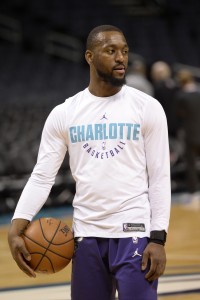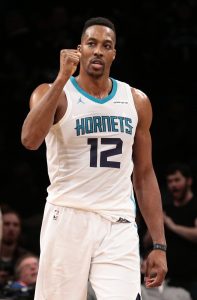After oscillating between lottery appearances and first-round playoff exits during Steve Clifford‘s first four years in Charlotte, the Hornets endured a second consecutive 36-46 season in 2017/18, resulting in Clifford’s ouster. The latest uninspiring stretch for the franchise, which hasn’t won a postseason series since being reborn in 2004, also resulted in the dismissal of general manager Rich Cho.
With Cho and Clifford out, former Lakers GM Mitch Kupchak has taken over the basketball operations department, hiring Spurs assistant James Borrego as the Hornets’ new head coach. Despite the changes in the front office and on the bench, 11 of Charlotte’s 14 players from 2017/18 – including the club’s top nine highest-paid veterans – have guaranteed contracts for next season, creating uncertainty about how much the actual roster will change.
Here are five key questions facing the franchise this summer:
1. Will the Hornets trade Kemba Walker?
Walker’s name surfaced in a number of rumors prior to the trade deadline, and it wasn’t simply baseless speculation. Hornets owner Michael Jordan confirmed that the club was listening to inquiries on its star point guard, though he cautioned that Charlotte wasn’t shopping Walker and said the price would be high.
The Hornets’ front office has undergone some changes since then, but Jordan will still be the one signing off on roster decisions and he sounds willing to approve a deal if Kupchak decides to go in that direction. Still, moving Walker for a fair return won’t be easy. The former UConn star has just one year left on his current contract, so any team interested in acquiring him would have to be pretty confident that he’d be willing to re-up.
Charlotte also reportedly has somewhat conflicting goals in a Walker trade. Jordan stated that the team would only move its point guard for an All-Star caliber player, but attaching an unwanted contract to Walker also represents the club’s best chance to dump salary. It’s unlikely that the team would be able to simultaneously achieve both goals.
2. How can the Hornets reduce team salary?
In Nicolas Batum ($24MM cap hit for 2018/19), Dwight Howard ($23.82MM), Marvin Williams ($14.09MM), Cody Zeller ($13.53MM), and Michael Kidd-Gilchrist ($13MM), the Hornets have five veterans who will earn more than Walker next season, and all of them except for Howard remain under contract for multiple years.
With those five players totaling more than $88MM on next year’s cap and providing modest production, the Hornets are hamstrung when it comes to upgrading their roster. Attaching one or two of those players to Walker in a trade would help Charlotte create a little financial flexibility and kick-start a rebuild, but if Walker isn’t moved, it’s not clear how the team can get out from under any of those contracts without attaching another asset.
If the Hornets simply want to create a little more breathing room below the tax line and cut costs slightly, Jeremy Lamb is probably the most realistic trade candidate. Lamb is entering a contract year and is more affordable ($7.49MM) than many of his teammates. He’s also coming off his best NBA season (12.9 PPG, .370 3PT%), meaning Charlotte could actually ask for a draft pick in a trade involving him, rather than having to surrender one.
3. Will the Hornets sit out free agency?
Even if the Hornets move Lamb or another one of their more expensive players, the odds of the team clearing any cap room are extremely slim. At best, Charlotte figures to have its $8.5MM mid-level exception available when the new league year begins on July 1.
The Hornets’ free agent pursuits this summer could provide a hint at what sort of players Kupchak and Borrego want to bring aboard, but it wouldn’t be a surprise if the club opts to sit out the first week or two of free agency, perhaps going bargain-hunting once the dust has settled.
The Hornets aren’t just one or two signings away from contention, and virtually all of last year’s contributors remain under contract. On top of that, team ownership may not be eager to carry a salary well over the cap again during a retooling period. As such, Charlotte’s offseason action may come almost exclusively via trades and the draft rather than on the free agent market.
4. What will the Hornets do with the No. 11 pick?
The Hornets’ roster doesn’t feature a ton of cornerstone pieces at the moment, but let’s assume the team wants to keep Walker and try to re-sign him in 2019. In that case, the backcourt has a pair of possible long-term building blocks in Walker and Malik Monk, making the frontcourt a greater area of concern for Charlotte in the draft.
As such, we could see the Hornets give serious consideration to players like Robert Williams, Kevin Knox, and Miles Bridges at the No. 11 spot in the draft. Bridges, in particular, would be an intriguing addition as an inexpensive alternative to veterans like Kidd-Gilchrist, Williams, and Batum. The MSU forward has upside as a two-way wing and is a “freakish” athlete, according to ESPN’s Jonathan Givony, who has Bridges going to Charlotte in his latest mock draft. The Hornets could use a player with that skill set.
Williams would also be an appealing option with Howard’s time in Charlotte likely nearing an end. The Texas A&M big man has the ability to evolve into a defensive anchor at center who won’t hurt you on the offensive end.
5. Will the Hornets explore a rookie scale extension with Frank Kaminsky?
The Hornets famously turned down a massive offer from the Celtics for the No. 9 pick in the 2015 draft, opting to use the selection to nab Kaminsky. Three years later, it’s not clear if the former Wisconsin standout has a long-term future in Charlotte, especially with a new general manager in place.
Kaminsky, who becomes extension-eligible for the first time on July 1, enjoyed his most productive season in 2017/18, averaging 11.1 PPG on .429/.380/.799 shooting in just 23.2 minutes per contest. Still, while he has potential to develop into a reliable stretch four or five on offense, Kaminsky isn’t a particularly effective rebounder or defender, limiting his value.
With so many multiyear commitments already on their books, the Hornets will likely wait until 2019’s free agent period to make a decision on Kaminsky, giving Kupchak more time to assess his long-term fit.
Here’s where things currently stand for the Hornets financially:
Guaranteed Salary
- Nicolas Batum ($24,000,000)
- Dwight Howard ($23,819,725)
- Marvin Williams ($14,087,500)
- Cody Zeller ($13,528,090)
- Michael Kidd-Gilchrist ($13,000,000)
- Kemba Walker ($12,000,000)
- Jeremy Lamb ($7,488,372)
- Frank Kaminsky ($3,627,842)
- Malik Monk ($3,447,480)
- Willy Hernangomez ($1,544,951)
- Dwayne Bacon ($1,378,242)
- Total: $117,922,202
Player Options
- None
Team Options
- None
Non-Guaranteed Salary
- Julyan Stone ($1,656,092)1
- Total: $1,656,092
Restricted Free Agents
- Treveon Graham ($1,699,698 qualifying offer / $1,699,698 cap hold): Early Bird rights
- Total: $1,699,698
Unrestricted Free Agents / Other Cap Holds
- No. 11 overall pick ($3,346,518)
- Michael Carter-Williams ($3,240,000): Non-Bird rights
- Total: $6,586,518
Projected Salary Cap: $101,000,000
Projected Cap Room: None
- With 11 of their 14 current players still on guaranteed contracts next year, the Hornets don’t have a whole lot of flexibility. Adding those 11 salaries to the team’s cap hold for its lottery pick works out to a total team salary of $121,268,720, which is well above the cap and may be right around the tax line.
Footnotes:
- Stone’s salary becomes fully guaranteed after August 1.
Note: Rookie scale cap holds are estimates based on salary cap projections and could increase or decrease depending on where the cap lands.
Salary information from Basketball Insiders was used in the creation of this post. Photos courtesy of USA Today Sports Images.
Gotta trade any vet they can. Time to reset the roster in the worst way. That team lacks so much there’s no quick fix
They have to start building on Monk, Willy & whoever they pick at the #11 this draft… & yeah try unload any of the big contracts, I cannot see how without giving out any young asset, best way is probably sacrifice Kemba, which would be better than 1st round picks in the next few years, as they can be high lottery with the way Charlotte is going.
Willy is way too popular given his accomplishments and PT. How does he do it
Keep re-building, when did they ever start? Same thing every year. Kemba was to be the build around franchise player, now there’s talk about trading him. No way! Kemba and Howard are a must stay. Replace the inconsistent dead wood. Spend some $$$ and stop worrying about the tax. I’d spend more for a ticket if I knew the Hornets were a playoff team. I know, same crap every year….